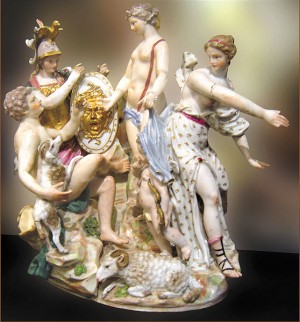Capodimonte, literally translated, “The top of the hill,” is the name given to the most delicate of all Italian porcelains. It was produced with soft-paste porcelains of only the highest grade by the top Italian artist of the day. The subject matter was drawn from nature with each piece requiring hours of painstaking hand work.
The earliest pieces will have no mark. Towards the end of the first decade of production the letter “N” beneath a crown was most commonly used, although a fleur-de-lis was occasionally added to the marking in either blue or gold. For assistance with identifying marks check out antique-marks.com/naples-porcelain.html for details and pictures.
The history of Capodimonte porcelain can be divided into four sections. The first factory, The Royal Manufactory of Porcelain, was established in 1743 in Naples on the grounds of the royal palace and operated successfully for 17 years under the direction of Charles the VII. The second factory opened in Madrid, Spain in 1777, where it flourished until 1834, when it closed, ending the era of authentic Capodimonte porcelain. Some of the original molds were purchased by the Ginori family of Doccia, Italy who produced wares until 1896 when the ownership transferred to Societa Ceramica of Milan which remains in production today.
The eras of production have produced very defined categories of collectors; those who look for only rare original works, those who watch for pre-1920 pieces, and largest group of collectors, those who enjoy acquiring “modern” pieces from the mid-20th century.
In addition to its obvious beauty, collectors are drawn to the large number of pieces available. Plates, vases, bowls, tea cups, jugs, sugar bowls, tea caddies, teapots, snuff-boxes, and walking stick handles mounted in gold are among the numerous fine wares produced at the original factory. Common finds in more recent issues include: figurines, coffee cups, lamps and candlesticks.
Before you go scurrying to check the marks on your collection, it is important to note that original pieces, if they can be had, are valued at thousands of dollars. They are extremely rare and most of the known existing ones have found their way into museums and high end private collections. Examples do occasionally appear at fine art auctions in the U.S. and Europe. If you have an interest in viewing some of this incredible Italian art, auction catalogs for Christie’s of New York or Sotheby’s will sometimes afford you this unique experience.
This beautiful pottery is one of the most highly imitated in the world. Hundreds of factories have copied not only the forms and the high relief floral decor, they have also reproduced the original marks for use on their wares. In addition to the Doccela factory in Italy, watch for pieces from France, Germany and most recently in China.
Your best bet for mid-20th century or older Capodimonte is an antique shop or a reputable private dealer. I would be leery of eBay as many people do not understand what they are selling and may accidentally misrepresent new as old. As for the TV shopping networks, if you like it, buy it! But understand it is a mass reproduction in China and brand new.
Capodimonte is as fragile as it is beautiful. The delicate flowers and petals chip and shatter very easily, even under the best of conditions. Avoid direct sunlight and temperature changes and whenever possible, display your collection behind glass to keep it free from dust. Should cleaning becomes necessary, gently dip the piece in and out of warm (soap free) water a few times and then allow to air dry. Until next time….Linda
Linda Kennett is a professional liquidation consultant specializing in down-sizing for seniors and the liquidation of estates and may be reached at 317-258-7835 or lkennett@indy.rr.com.



